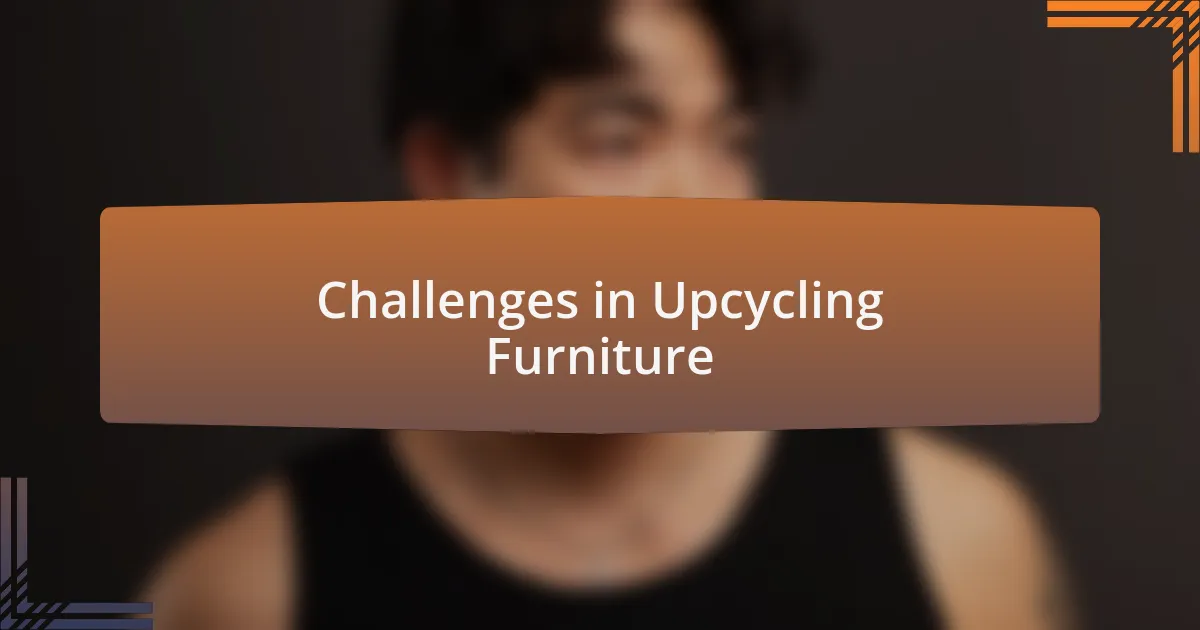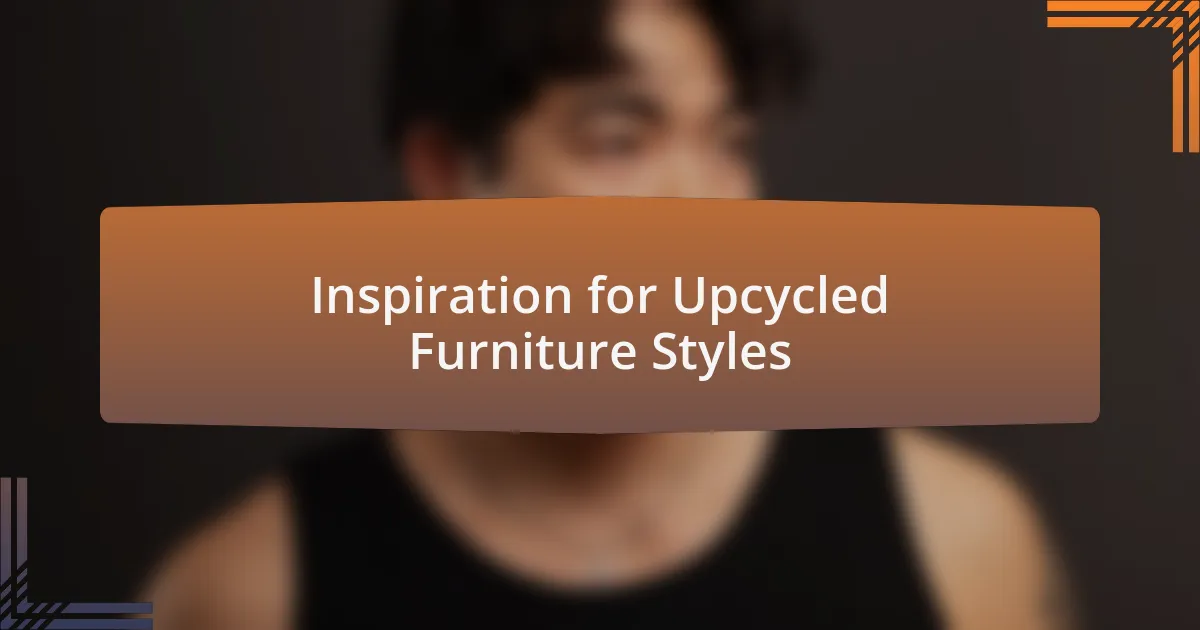Key takeaways:
- Upcycling furniture is both a creative process and a personal expression that connects past experiences with future possibilities.
- It offers significant benefits, including cost savings, waste reduction, and a sense of accomplishment through hands-on transformation.
- Challenges in upcycling often involve sourcing materials, physical labor, and managing time constraints, which can be overcome by planning and perseverance.
- Inspiration for upcycling can be found in nature, colors, and the stories behind the furniture, enhancing the creative journey and final product.

Understanding Upcycling Furniture Styles
Upcycling furniture is a transformative process that breathes new life into old pieces, changing their function and aesthetic. When I first decided to upcycle a worn-out chair, I felt a mix of excitement and apprehension. I wondered, could I really turn this forgotten furniture into something beautiful? As I painted and customized, I discovered not just a new design but a deeper appreciation for creativity and resourcefulness.
Understanding the different styles of upcycling is essential for making informed choices. For instance, rustic styles often embrace imperfections, allowing the raw beauty of the wood to shine through, while modern designs may focus on sleek lines and minimalism. I once tackled an outdated dresser, opting for a shabby-chic approach, which led to a surprising emotional connection—I felt like I was preserving its history while giving it a fresh start.
One important aspect to consider is how upcycling reflects personal taste and lifestyle. Have you ever thought about how your furniture choices represent your journey? I remember incorporating bold colors and artistic designs in my upcycled pieces, expressing my evolving style and positivity. Upcycling isn’t just about what’s practical; it’s an art form that connects us to our past while shaping our future.

The Benefits of Upcycling Furniture
One of the most rewarding aspects of upcycling furniture is the profound sense of accomplishment it provides. I remember the first time I transformed an old coffee table into a vibrant art piece. As I sanded down the surface and applied a burst of color, I felt a rush of excitement—not just about the finished product but also about the creative journey itself. It’s amazing how the process can ignite passions and foster skills I never knew I had.
Economically, upcycling can lead to significant savings. When I converted a thrift store find into a stylish corner shelf, I realized I had saved a considerable amount compared to purchasing new furniture. This reshaping didn’t just make my home more personalized; it also showed me how resourcefulness could be both beautiful and budget-friendly. Have you considered how much you could save while simultaneously expressing your unique style?
Moreover, upcycling is a sustainable practice that reduces waste, which is incredibly important given today’s environmental challenges. Each time I breathe new life into discarded items, I feel like I’m making a small contribution to a healthier planet. Isn’t it nice to think that your creative efforts can play a part in preserving resources for future generations? This perspective has driven my dedication to upcycling and inspires others to think twice before tossing out their old furniture.

Popular Upcycled Furniture Techniques
One popular technique that I’ve embraced is painting furniture with bold colors or unique patterns. I vividly recall the satisfaction of turning an outdated dresser into a stunning focal piece by layering vibrant hues and adding stencils. Have you ever thought about how a splash of color can completely transform not just a piece of furniture, but an entire room’s atmosphere?
Another method I find particularly rewarding is reupholstering old chairs or couches. I once took an inherited armchair—covered in a fabric that had seen better days—and gave it a complete makeover with a trendy print. The moment I placed it back in my living room, I felt a surge of pride, realizing that I wasn’t just reviving a piece of my family’s history but also adding a unique character to my space.
Lastly, I love the challenge of repurposing. One time, I converted an old wooden ladder into a stylish bookshelf. It was thrilling to watch something once seemingly obsolete find a new purpose while still holding onto its rustic charm. Have you considered how creativity in functional design can lead to surprises around every corner of your home? Each upcycling project has taught me that with a little imagination, the possibilities are truly endless.

My Journey into Upcycling Furniture
Embarking on my journey into upcycling furniture began quite unexpectedly. One sunny afternoon, while rummaging through a garage sale, I stumbled upon an old trunk that had clearly seen better days. Despite its battered exterior, I felt an undeniable urge to rescue it—what stories must it hold? I decided then and there that I would give it a new life as a coffee table.
As I rolled up my sleeves and got to work, I embraced the mess of sawdust and paint. I vividly remember the first coat of glossy finish going on; it was as if I was breathing magic back into the wood. The transformation was exhilarating, and with each stroke, I felt a deeper connection to the piece. Who would have thought that my initial impulse would lead me to discover not just an eye for design, but also a therapeutic outlet?
Over time, I learned that these projects are about more than just the final product—they’re a deeply personal expression of my creativity. For instance, when I turned a worn-out dining table into a chic writing desk adorned with family photographs, it made the piece truly mine. Looking at it now, I can’t help but smile, thinking of how every crack and paint drip tells a story. Have you ever felt the joy of creating something entirely your own? That’s the essence of upcycling furniture for me: it’s about crafting not just functional items, but cherished memories.

Challenges in Upcycling Furniture
When diving into upcycling, I quickly realized that finding the right materials can be a real challenge. One time, I spent hours at thrift stores and garage sales, all in search of the perfect dresser to transform into a stunning new piece. I had my heart set on a specific style, but many items were either too damaged or not quite what I envisioned. It made me wonder: How do you know when to compromise on your vision, and when to keep searching?
Another hurdle I faced was the physical labor involved. I remember wrestling with the old hardware on a seemingly straightforward project—a coffee table redo. Removing the worn-out legs took more effort than I anticipated, and I often found myself caught in a battle between persistence and frustration. Have you ever felt like giving up when a project turns out tougher than expected? I certainly did, but eventually, the satisfaction of overcoming those obstacles became part of the joy in upcycling.
Time constraints can also be a significant factor. Juggling work and family commitments meant that long nights in the workshop were often out of the question. I vividly recall one weekend where I rushed to finish a project for a friend’s birthday; it was a race against the clock. This experience taught me the importance of balancing my upcycling passion with reality, reminding me that creativity thrives when given the space to breathe. Have you ever had to navigate those tricky time conflicts with your own projects?

Tips for Successful Upcycling Projects
When embarking on an upcycling project, one of the best pieces of advice I can share is to start with a clear vision. I once began working on an old wooden chair without a plan, which left me feeling lost halfway through. Trust me, sketching out what you want to achieve can save you from making costly mistakes. Have you ever walked into a project with no direction and ended up frustrated? I certainly have.
Another essential tip is to embrace the imperfections. I recall transforming an antique side table that had some quirky flaws—a chipped corner and uneven legs. Rather than trying to hide them, I decided to accentuate these features with creative painting techniques. This approach not only made the table unique but also turned it into a conversation piece at my last gathering. So, have you considered that sometimes the best stories come from flaws?
Finally, keep your toolbox stocked with versatile supplies. I learned this lesson after embarking on a project that required unexpected repairs to a broken drawer. Having a variety of tools and materials on hand, like extra paint, handles, or wood filler, made all the difference. It saved me multiple trips to the store and allowed me to work uninterrupted. Have you thought about how being prepared can enhance your crafting experience? I know it has for me.

Inspiration for Upcycled Furniture Styles
One impactful source of inspiration for upcycled furniture is nature itself. I once transformed an old dresser into a stunning garden planter, repurposing its drawers to hold pots of herbs and flowers. Watching the natural elements blend with the crafted wood sparked a realization: sometimes, inspiration sprouts in the most unexpected places. Have you ever considered how the world around you can influence your designs?
Another avenue to explore is the vibrant world of color. I vividly remember when I painted a faded bookshelf in a bold turquoise hue, instantly breathing new life into it. This simple change not only brightened my living space but also inspired me to experiment with a variety of shades and patterns. How does color affect your mood? For me, it can turn a mundane item into a captivating focal point.
Finally, don’t underestimate the power of storytelling in your projects. When I refurbished a set of vintage chairs, I learned their history from the previous owner, which guided my design decisions. Incorporating elements that reflect the narrative behind the furniture not only honors its past but also adds a layer of depth. Isn’t it fascinating how each piece can carry its own story, waiting for you to tell it through your unique creative lens?